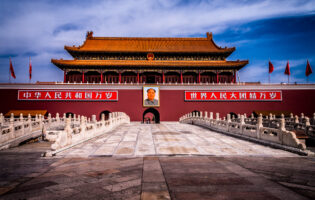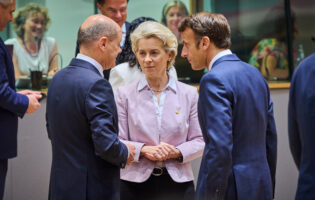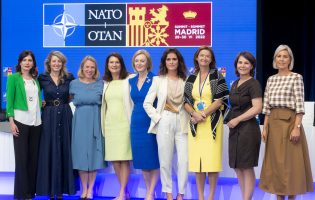
Partners in A Changing World: The Rosy Chinese-Russian Relationship and Its Implications for the Transatlantic Relationship

Yixiang Xu
China Fellow; Program Officer, Geoeconomics
Yixiang Xu is the China Fellow and Program Officer, Geoeconomics at AGI, leading the Institute’s work on U.S. and German relations with China. He has written extensively on Sino-EU and Sino-German relations, transatlantic cooperation on China policy, Sino-U.S. great power competition, China's Belt-and-Road Initiative and its implications for Germany and the U.S., Chinese engagement in Central and Eastern Europe, foreign investment screening, EU and U.S. strategies for global infrastructure investment, 5G supply chain and infrastructure security, and the future of Artificial Intelligence. His written contributions have been published by institutes including The Chinese Academy of Social Sciences, The United States Institute of Peace, and The Asia Society's Center for U.S.-China Relations. He has spoken on China's role in transatlantic relations at various seminars and international conferences in China, Germany, and the U.S.
Mr. Xu received his MA in International Political Economy from The Josef Korbel School of International Studies at The University of Denver and his BA in Linguistics and Classics from The University of Pittsburgh. He is an alumnus of the Bucerius Summer School on Global Governance, the Global Bridges European-American Young Leaders Conference, and the Brussels Forum's Young Professionals Summit. Mr. Xu also studied in China, Germany, Israel, Italy, and the UK and speaks Mandarin Chinese, German, and Russian.
__
Since the 2016 U.S. presidential election, Europeans have reflected on the transatlantic relationship they’ve known for over seven decades, and which now seems to be at risk. Guided by an “America First” rhetoric, a transactional approach to U.S. foreign policy and potential U.S. disengagement from key international institutions, President Donald Trump is forcing Europe to rethink its foreign and security policy and to seriously contemplate a multipolar world without strong U.S. leadership or advancing Western democratic values.
Europe’s frustration over the changing transatlantic relationship is paralleled by another bilateral relationship that expanded in the post-Cold War years and continues to seek to benefit from a changing international political landscape. In the 1990s, Russia’s struggle to preserve its influence out of the ashes of the Soviet Union and China’s quest for rapid economic development brought the two countries together as partners. The hostile Sino-Soviet split of the early 1960s was replaced by a mutual discomfort toward a U.S.-led world dominated by Western norms and values.
Yeltsin’s 1996 declaration of a Russo-Chinese strategic partnership came at a time when unilateral U.S. interventions in the Balkans and further NATO expansion to the east after German reunification greatly unsettled Russia. At the same time, accusations of human rights violations and economic sanctions brought by the U.S.-led response to the 1989 Tiananmen Square incident angered China. Thus, a shared resentment of the post-Cold War international security architecture and Western emphasis on human rights and democratic values brought the two countries together in their pursuit of a multipolar world order that accommodates different regime types and assures non-interference in countries’ internal affairs.
In recent years, Chinese-Russian cooperation accelerated on multiple fronts. Driven by an acute understanding of the countries’ respective geopolitical needs, the bilateral relationship adopted close short-term coordination on matters of common interests. Trade and investment grew, culminating in $69.52 billion of trade turnover in 2016,[1] making China the biggest trading partner for Russia. A goal to reach a bilateral trade volume of $200 billion by 2020 has also been mentioned during regular meetings between the heads of the two governments.[2] Starved by Western sanctions, Russia increasingly looks to China for investment capital. China’s hunger for energy also matches the Kremlin’s push to diversify and expand its energy markets with the launch of high-profile projects such as the Altai and the Power of Siberia pipelines. Furthermore, both sides benefit from weapons and military technology sales from Russia to China. The two countries have recently embarked on joint projects to build wide-body commercial jets[3] and heavy transport helicopters.[4]
Russia’s tense relationship with its Muslim republics in the Caucasus and China’s trouble with its Muslim Uyghur population in the northwestern Xingjiang province unite the two countries in their efforts to oppose the spread of radical Islam as well as separatism and terrorism in central Asia, resulting in bilateral security cooperation through the Shanghai Cooperation Organization (SCO) and curious programs like the Chinese special force training in Chechnya.[5] China and Russia’s coordination of their foreign policy preferences on a variety of platforms ranging from the UN Security Council to BRICS Summit to SCO to the newly formed Asian Infrastructure Investment Bank (AIIB) has given both parties amplified voice. China’s One-Belt-One-Road (OBOR) strategy seems to complement Russia’s Eurasia Economic Union (EAEU) in central Asia. Following U.S. withdrawal from the Trans-Pacific Partnership (TTP), China and Russia are pushing for regional trade agreements in the Asia-Pacific region, such as the Regional Comprehensive Economic Partnership (RCEP) and the Free Trade Area for the Asia Pacific Region (FTAAP).[6] The Chinese-Russian relationship is positioning itself as a stable and responsible partnership open to regional and global interests.
In comparison, the transatlantic relationship seems frail with the Trump administration’s shifting attitude toward collective security under NATO and dim prospects for TTIP. Nationalist populism in Europe and the U.S. is threatening to diminish U.S. leadership and with it the Western democratic agenda for global governance. As Europeans and Americans increasingly turn inward, China and Russia’s shared vision for a multipolar world order with regional power centers and preference of bilateral deals over rules appears to be more relevant than ever.
If there is something the transatlantic relationship can learn from the rosy Chinese-Russian partnership, it is neither the “strategic” nature of the relationship nor the manifestations of its objectives. Careful geopolitical calculations of mutual interests, not vision of a shared destiny, are the driving forces of close Sino-Russian relations. The expansion of Chinese interests in Central Asia carries an undertone that challenges Russia’s struggle to preserve its historic influence in the region. Massive Chinese migration to Russia’s Far East, estimated between 2 and 5 million, has provoked fear and resentment from locals. Contractual disagreements and political reconsiderations often stall or delay joint trade and investment projects, such as the Altai pipeline and the Amur bridge. There’s no guarantee for lasting alliance or unwavering commitment. Under the façade of blooming bilateral relations, trust is still a commodity in short supply.
For Europe and the U.S., trust is woven into the fabric of the post-WWII transatlantic relationship. Close transatlantic cooperation in security, development, and trade and investment form the backbone of Western democracy. Beyond mutual interests, shared values and a common vision for a rule-based international order are the foundations of the international norms and institutions that shape the world we live in. In a changing world where regional power centers like China and Russia push for bilateral approaches to global governance based on national interests and geopolitical calculations, it is even more important for Europe and the U.S. to resist the temptation of joining the flow. There is no need to reengineer the parameters of the partnership. The challenge ahead is to rekindle the spirit of strong transatlantic ties and reaffirm our commitment to each other and to the common vision we have for the world.
[1] «China increased its oil imports in 2016 by 13.6%”: “Китай увеличил импорт нефти в 2016 году на 13,6%,” TACC, 12 January 2017, http://tass.ru/ekonomika/3937683
[2] “Medvedev and Li Keqiang will visit the Hermitage before the Russian-Chinese negotiations in St. Petersburg”: “Медведев и Ли Кэцян посетят Эрмитаж перед российско-китайскими переговорами в Петербурге,” TACC, 6 November 2017, http://tass.ru/politika/3760998
[3] “China and Russia assign responsibilities of making wide-body aircraft,” Sino Finance: “中俄正分配制造宽体飞机的职责, ”新浪财经, 1 March 2017, http://finance.sina.com.cn/stock/usstock/c/2017-03-01/doc-ifycaafm4618398.shtml
[4] “Will Ukraine participate in Sino-Russian research or directly sell advanced engines to China?” The Globe: “乌方将参与中俄合研重直?或直接售华先进发动机,”环球网, 15 February 2017, http://mil.huanqiu.com/observation/2017-02/10130557.html
[5] “Chinese special forces want to learn in Chechnya”: “Китайский спецназ хочет учиться в Чечне,” Gazeta.ru, December 14, 2016. https://www.gazeta.ru/army/2016/12/14/10426007.shtml
[6] “Russia, China, and Japan Fill the Trump Gap,” Bloomberg, 1 December 2016, https://www.bloomberg.com/news/articles/2016-12-01/russia-china-and-japan-fill-the-trump-trade-gap








